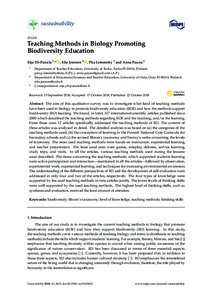Teaching Methods in Biology Promoting Biodiversity Education
Eija Yli-Panula; Piia Lemmetty; Eila Jeronen; Anna Pauna
https://urn.fi/URN:NBN:fi-fe2021042719913
Tiivistelmä
The aim of this qualitative survey was to investigate what kind of teaching methods have been used in biology to promote biodiversity education (BDE) and how the methods support biodiversity (BD) learning. We found, in total, 317 international scientific articles published since 2000 which described the teaching methods regarding BDE and the teaching, and/or the learning. From these ones 12 articles specifically addressed the teaching methods of BD. The content of these articles was analysed in detail. The detailed analysis was based on (a) the categories of the teaching methods used, (b) the conception of learning in the Finnish National Core Curricula for Secondary schools and (c) the revised Bloom’s taxonomy and Stanny’s verbs concerning the levels of taxonomy. The most used teaching methods were hands-on instruction, experiential learning, and teacher presentation. The least used ones were games, roleplay, debates, service learning, study trips, and visits. In all the articles, various teaching methods used during the lessons were described. The items concerning the teaching methods, which supported students learning were active participation and interaction—mentioned in all the articles—followed by observation, experimental work, experiential learning, and techniques for increasing environmental awareness. The understanding of the different perspectives of BD and the development of self-evaluation were addressed in only four and two of the articles, respectively. The four types of knowledge were supported by the used teaching methods in nine articles jointly. The lower levels of thinking skills were well-supported by the used teaching methods. The highest level of thinking skills, such as synthesis and evaluation, received the least amount of attention.
Kokoelmat
- Rinnakkaistallenteet [19207]
